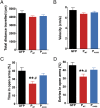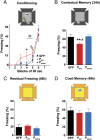Hippocampal expression of a virus-derived protein impairs memory in mice
- PMID: 29378968
- PMCID: PMC5816149
- DOI: 10.1073/pnas.1711977115
Hippocampal expression of a virus-derived protein impairs memory in mice
Abstract
The analysis of the biology of neurotropic viruses, notably of their interference with cellular signaling, provides a useful tool to get further insight into the role of specific pathways in the control of behavioral functions. Here, we exploited the natural property of a viral protein identified as a major effector of behavioral disorders during infection. We used the phosphoprotein (P) of Borna disease virus, which acts as a decoy substrate for protein kinase C (PKC) when expressed in neurons and disrupts synaptic plasticity. By a lentiviral-based strategy, we directed the singled-out expression of P in the dentate gyrus of the hippocampus and we examined its impact on mouse behavior. Mice expressing the P protein displayed increased anxiety and impaired long-term memory in contextual and spatial memory tasks. Interestingly, these effects were dependent on P protein phosphorylation by PKC, as expression of a mutant form of P devoid of its PKC phosphorylation sites had no effect on these behaviors. We also revealed features of behavioral impairment induced by P protein expression but that were independent of its phosphorylation by PKC. Altogether, our findings provide insight into the behavioral correlates of viral infection, as well as into the impact of virus-mediated alterations of the PKC pathway on behavioral functions.
Keywords: dentate gyrus; hippocampus; memory; protein kinase C; virus.
Conflict of interest statement
The authors declare no conflict of interest.
Figures





Similar articles
-
Mutation of the protein kinase C site in borna disease virus phosphoprotein abrogates viral interference with neuronal signaling and restores normal synaptic activity.PLoS Pathog. 2009 May;5(5):e1000425. doi: 10.1371/journal.ppat.1000425. Epub 2009 May 8. PLoS Pathog. 2009. PMID: 19424436 Free PMC article.
-
Borna disease virus phosphoprotein impairs the developmental program controlling neurogenesis and reduces human GABAergic neurogenesis.PLoS Pathog. 2015 Apr 29;11(4):e1004859. doi: 10.1371/journal.ppat.1004859. eCollection 2015 Apr. PLoS Pathog. 2015. PMID: 25923687 Free PMC article.
-
Borna disease virus blocks potentiation of presynaptic activity through inhibition of protein kinase C signaling.PLoS Pathog. 2006 Mar;2(3):e19. doi: 10.1371/journal.ppat.0020019. Epub 2006 Mar 17. PLoS Pathog. 2006. PMID: 16552443 Free PMC article.
-
Borna disease virus interference with neuronal plasticity.Virus Res. 2005 Aug;111(2):224-34. doi: 10.1016/j.virusres.2005.04.011. Virus Res. 2005. PMID: 15885838 Review.
-
Borna disease--neuropathology and pathogenesis.Curr Top Microbiol Immunol. 1995;190:39-73. Curr Top Microbiol Immunol. 1995. PMID: 7789150 Review.
Cited by
-
Borna disease virus docks on neuronal DNA double-strand breaks to replicate and dampens neuronal activity.iScience. 2021 Dec 16;25(1):103621. doi: 10.1016/j.isci.2021.103621. eCollection 2022 Jan 21. iScience. 2021. PMID: 35024577 Free PMC article.
-
Impact of Borna Disease Virus Infection on the Transcriptome of Differentiated Neuronal Cells and Its Modulation by Antiviral Treatment.Viruses. 2023 Apr 10;15(4):942. doi: 10.3390/v15040942. Viruses. 2023. PMID: 37112922 Free PMC article.
-
Engagement of Neurotropic Viruses in Fast Axonal Transport: Mechanisms, Potential Role of Host Kinases and Implications for Neuronal Dysfunction.Front Cell Neurosci. 2021 Jun 21;15:684762. doi: 10.3389/fncel.2021.684762. eCollection 2021. Front Cell Neurosci. 2021. PMID: 34234649 Free PMC article.
-
C-type lectin receptor DCIR contributes to hippocampal injury in acute neurotropic virus infection.Sci Rep. 2021 Dec 10;11(1):23819. doi: 10.1038/s41598-021-03201-2. Sci Rep. 2021. PMID: 34893671 Free PMC article.
-
Early Transcriptional Changes in Rabies Virus-Infected Neurons and Their Impact on Neuronal Functions.Front Microbiol. 2021 Dec 13;12:730892. doi: 10.3389/fmicb.2021.730892. eCollection 2021. Front Microbiol. 2021. PMID: 34970230 Free PMC article.
References
-
- Marder SR. Perspective: Retreat from the radical. Nature. 2014;508:S18. - PubMed
-
- Abbott A. Novartis reboots brain division. Nature. 2013;502:153–154. - PubMed
-
- Kitajewski J, et al. Adenovirus VAI RNA antagonizes the antiviral action of interferon by preventing activation of the interferon-induced eIF-2 alpha kinase. Cell. 1986;45:195–200. - PubMed
Publication types
MeSH terms
Substances
LinkOut - more resources
Full Text Sources
Other Literature Sources

